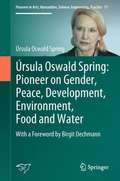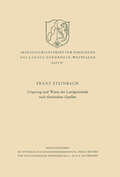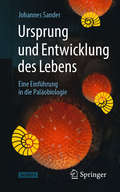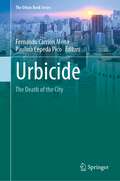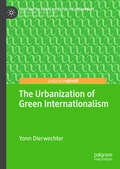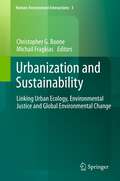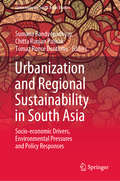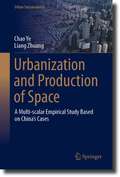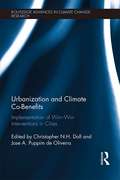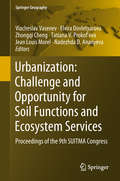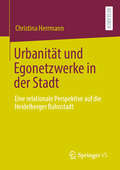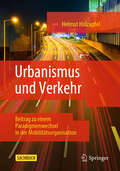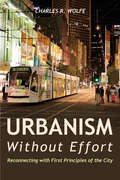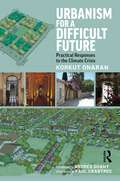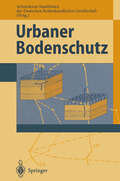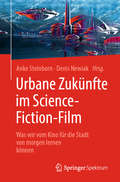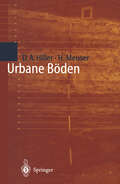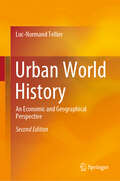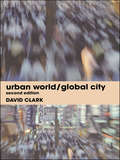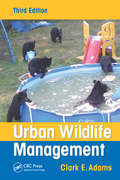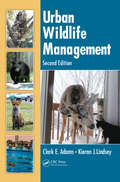- Table View
- List View
Úrsula Oswald Spring: With a Foreword by Birgit Dechmann (Pioneers in Arts, Humanities, Science, Engineering, Practice #17)
by Úrsula Oswald SpringThis book aims to initiate among students and other readers critical and interdisciplinary reflections on key problems concerning development, gender relations, peace and environment, with a special emphasis on North-South relations. This volume offers a selection of the author's research in different parts of the world during 50 years of contributing to an interdisciplinary scientific debate and addressing social answers to urgent global problems. After the author's biography and bibliography, the second part analyses the development processes of several countries in the South that resulted in a dynamic of underdevelopment. The deep-rooted gender discrimination is also reflected in the destructive exploitation of natural resources and the pollution of soils, water and air. Since the beginning of the Anthropocene in the mid-20th century, the management of human society and global resources has been unsustainable and has created global environmental change and multiple conflicts over scarce and polluted resources. Peace and development policies aiming at gender equity and sustainable environmental management, where water and food are crucial for the survival of humankind, focus on systemic alternatives embedded in a path of sustainability transition.• This book reviews multiple influences from Europe, Africa and Latin America on a leading social scientist and activist on gender, development and environment aiming at a world with equity, sustainability, peace and harmony between nature and humans.• This pioneer volume analyses social and environmental conflicts and peace processes in Latin America, with a special focus on Mexico, by addressing the development of under-development, global environmental change, poverty, nutrition and the North-South gap.• This volume focuses on environmental deterioration with a special emphasis on food and water and proposes systemic changes towards a sustainability transition with peace, regional development and gender equity.• This pioneering work offers alternative approaches to regional development, food sovereignty and holistic development processes from a gender perspective.
Ursprung und Wesen der Landgemeinde nach rheinischen Quellen (Arbeitsgemeinschaft für Forschung des Landes Nordrhein-Westfalen #87)
by Franz SteinbachUrsprung und Entwicklung des Lebens: Eine Einführung in die Paläobiologie
by Johannes SanderSie wollten schon immer einmal wissen, wie das Leben begann, sich entfaltete und schließlich zu seiner heutigen Form fand? Das vorliegende Buch bietet Ihnen einen kurzen, gleichzeitig aber auch umfassenden Einblick in diese spannende Entwicklung. Ausgehend von den kosmischen Prozessen, die die Voraussetzungen für die Entstehung von Leben auf der Erde schufen, über die Entstehung des Lebens selbst bis hin zu der weiteren Evolution des Lebens über die Jahrmillionen hinweg, erhalten Sie einen weitreichenden Einblick in diese Abläufe. Zudem erklärt dieses Buch die Hintergründe und Ursachen für die Entwicklung in bestimmte Richtungen. Berücksichtigt werden dabei neben den oft im Vordergrund stehenden Wirbeltieren auch Mikroorganismen, Pflanzen und Insekten. Zuletzt beschreibt das Buch anschaulich die Entwicklung des Menschen – jener Spezies, mit der uns alle eine besondere Beziehung verbindet!
Urbicide: The Death of the City (The Urban Book Series)
by Fernando Carrión Mena Paulina Cepeda PicoThis book uses the reflection of academics specialized in the urban area of Latin America, Europe and the United States, to initiate a comparative debate of the different dynamics in which Urbicidio expresses itself. The field or focal point of analysis that this publication approaches is the city, but under a new critical perspective of inverse methodology to that has been traditional used. It is about understanding the structural causes of self-destruction to finally thinking better and then going from pessimism to optimism.It is a deep look at the city from an unconventional entrance, because it is about knowing and analyzing what the city loses by the action deployed by own urbanites, both in the field of its production and in the field of its consumption. This suppose that the city does not have an ascending linear sequential evolution in its development but neither in each of its parts in the improvement process, showing the face that commonly not seen but others live. The category used for this purpose is that of Urbicidio or the death of the city, which contributes theoretically and methodologically to the knowledge of the city, as well as to the design of urban policies that neutralize it. In addition, it is worth mentioning that the book has an inclusive view of the authors. For this reason, gender parity, territorial representation and the presence of age groups have been sought.
The Urbanization of Green Internationalism (Cities and the Global Politics of the Environment)
by Yonn DierwechterThe recent rise of cities in global environmental politics has stimulated remarkable debates about sustainable urban development and the geopolitics of a changing world order no longer defined by tightly bordered national regimes. This book explores this major theme by drawing on approaches that document the diverse histories and emergent geographies of “internationalism.” It is no longer possible, the book argues, to analyze the global politics of the environment without considering its various urbanization(s), wherein multiple actors are reforming, reassembling and adapting to nascent threats posed by global ecological decay. The ongoing imposition and abrasion of different world orders—Westphalian and post-Westphalian—further suggests we need a wider frame to capture new kinds of urbanized spaces and global green politics. The book will appeal to students, scholars, and practitioners interested in global sustainability, urban development, planning, politics, and international affairs. Case studies and grounded examples of green internationalism in urban action ultimately explore how select city-regions like Cape Town, Los Angeles, and Melbourne are trying to negotiate and actually work through this postulated dilemma.
Urbanization and Sustainability: Linking Urban Ecology, Environmental Justice and Global Environmental Change (Human-Environment Interactions #3)
by Christopher G. Boone and Michail FragkiasCase studies explore the Million Trees initiative in Los Angeles; the relationship of cap-and-trade policy, public health, greenhouse gas emissions and environmental justice in Southern California; Urbanization, vulnerability and environmental justice in the Brazilian cities of Rio de Janeiro, Curitiba and São Paulo, and in Antofagasta, Greater Concepción and Valparaiso in Chile; Sociospatial patterns of vulnerability in the American southwest; and Urban flood control and land use planning in Greater Taipei, Taiwan ROC.
Urbanization and Regional Sustainability in South Asia: Socio-economic Drivers, Environmental Pressures and Policy Responses (Contemporary South Asian Studies)
by Sumana Bandyopadhyay Chitta Ranjan Pathak Tomaz Ponce DentinhoThis book examines urbanization and migration processes in South Asia. By analyzing the socio-economic impacts and infrastructural, environmental and institutional aspects of different conurbations, it highlights conflicts over agricultural land as well as the effects on health, education, poverty and the welfare of children, women and old people. The authors also explore issues of mobility; connectivity and accessibility of public services, and discuss the effective use of new urban-management tools, such as the concept of smart cities and urban spatial monitoring.
Urbanization and Production of Space: A Multi-scalar Empirical Study Based on China's Cases (Urban Sustainability)
by Chao Ye Liang ZhuangThis book studies China’s urbanization with the theory of production of space. The authors redefine the production of space and build a new theoretical framework for understanding the evolving relations between urbanization and spatial production. Since the reform and opening-up, especially in the last twenty years, the logic of spatial production has dominated China’s urbanization. The authors choose the most representative cases, such as the Yangtze River Delta Urban Agglomeration, Jiangsu Province, National High-tech Industrial Development Zone, New Urban District, State-Level New Area, University Town, and some villages, to conduct a series of empirical studies on production of space at the macro-, meso-, and micro-scales. Through an in-depth analysis of the interaction between social spaces and urbanization influenced by power, capital, and class, the book reveals that the essence of China’s urbanization is dominated by the logic of spatial production. The authors finally propose that an important shift toward humanism should be made in the future development of China’s new-type urbanization, emphasizing more even and adequate development between different regions and between urban and rural areas, which also provides new ideas for the theory and practice of urbanization worldwide.This book can be read and referenced by researchers in the fields of urban and regional studies, geography, sociology, urban and rural planning, management, etc. It can also be used as a teaching reference book for teachers, researchers, and students of scientific research institutions in related fields.
Urbanization and Climate Co-Benefits: Implementation of win-win interventions in cities (Routledge Advances in Climate Change Research)
by Christopher N.H. Doll and Jose A. Puppim de OliveiraUrban areas are increasingly contributing to climate change while also suffering many of its impacts. Moreover, many cities, particularly in developing countries, continue to struggle to provide services, infrastructure and socio-economic opportunities. How do we achieve the global goals on climate change and also make room for allowing global urban development? Increasing levels of awareness and engagement on climate change at the local level, coupled with recent global agreements on climate and development goals, as well as the New Urban Agenda emerging from Habitat III, present an unprecedented opportunity to radically rethink how we develop and manage our cities. Urbanization and Climate Co-Benefits examines the main opportunities and challenges to the implementation of a co-benefits approach in urban areas. Drawing on the results of empirical research carried out in Brazil, China, Indonesia, South Africa, India and Japan, the book is divided into two parts. The first part uses a common framework to analyse co-benefits across the urban sectors. The second part examines the tools and legal and governance perspectives at the local and international level that can help in planning for co-benefits. This book will be of great interest to students, practitioners and scholars of urban studies, climate/development policy and environmental studies.
Urbanization and Climate Co-Benefits: Implementation of win-win interventions in cities (Routledge Advances in Climate Change Research)
by Christopher N. H. Doll Jose A. Puppim De OliveiraUrban areas are increasingly contributing to climate change while also suffering many of its impacts. Moreover, many cities, particularly in developing countries, continue to struggle to provide services, infrastructure and socio-economic opportunities. How do we achieve the global goals on climate change and also make room for allowing global urban development? Increasing levels of awareness and engagement on climate change at the local level, coupled with recent global agreements on climate and development goals, as well as the New Urban Agenda emerging from Habitat III, present an unprecedented opportunity to radically rethink how we develop and manage our cities. Urbanization and Climate Co-Benefits examines the main opportunities and challenges to the implementation of a co-benefits approach in urban areas. Drawing on the results of empirical research carried out in Brazil, China, Indonesia, South Africa, India and Japan, the book is divided into two parts. The first part uses a common framework to analyse co-benefits across the urban sectors. The second part examines the tools and legal and governance perspectives at the local and international level that can help in planning for co-benefits. This book will be of great interest to students, practitioners and scholars of urban studies, climate/development policy and environmental studies.
Urbanization: Proceedings of the 9th SUITMA Congress (Springer Geography)
by Viacheslav Vasenev Elvira Dovletyarova Zhongqi Cheng Tatiana V. Prokof’eva Jean Louis Morel Nadezhda D. AnanyevaThis proceedings volume focuses on different aspects of environmental assessment, monitoring, and management of urban and technogenic soils. Soils of Urban, Industrial, Traffic, Mining and Military Areas (SUITMAs) differ substantially from their natural zonal counterparts in their physical, chemical and biological features, their performed functions, and supported services.This book discusses the monitoring, analysis and assessment of the effects of urbanization on soil functions and services. Further, it helps to find solutions to the environmental consequences of urbanization and discusses best management practices such as management and design of urban green infrastructure, waste management, water purification, and reclamation and remediation of contaminated soils in the context of sustainable urban development.The book includes thematic sections corresponding to 14 sessions of the SUITMA 9 congress, covering broad topics that highlight the importance of urban soils for society and environment and summarizing the lessons learned and existing methodologies in analyses, assessments, and modeling of anthropogenic effects on soils and the related ecological risks.This proceedings book appeals to scientists and students as well as practitioners in soil and environmental science, urban planning, geography and related disciplines, and provides useful information for policy makers and other stakeholders working in urban management and greenery.
Urbanität und Egonetzwerke in der Stadt: Eine relationale Perspektive auf die Heidelberger Bahnstadt
by Christina HerrmannUrbanität haftet Individuen weder einfach als Habitus an, noch ist sie in einer Stadt per se gegeben. Vielmehr muss auf die Wechselwirkungen von Stadtraum – sozialen Beziehungen – und Einstellungen rekurriert werden, um zu verstehen, wie die sozialen Netzwerke in der Stadt Offenheit für Urbanität hervorbringen. Christina Herrmann betrachtet den geplanten, neu gebauten Heidelberger Stadtteil Bahnstadt als soziales Labor und untersucht lokale soziale Beziehungen, sowie deren Einfluss auf die Offenheit gegenüber Urbanität qualitativ, quantitativ und netzwerkanalytisch. Dabei thematisiert dieses Buch neben klassischen relationalen Ansätzen auch die Diskussion um die nachhaltige Stadt in der Wissensgesellschaft und die Situationen von jungen Familien in der Stadt.
Urbanismus und Verkehr: Beitrag zu einem Paradigmenwechsel in der Mobilitätsorganisation
by Helmut HolzapfelDas Sachbuch, jetzt in der dritten erneut überarbeiteten Auflage beinahe schon ein Klassiker der interdisziplinär begriffenen Verkehrs- und Stadtforschung, ist aktueller denn je. Es vermittelt auf kluge Weise Kenntnisse, der historischen und sozio-kulturellen Wurzeln einer einseitig vom Automobil dominierten Perspektive der Verkehrsplanung. Es zeigt die Entwicklung einer von fossiler Energie getriebenen Planung, die seit Jahrzehnten die sozialen und ökologischen Systeme überfordert, und vermittelt darüber hinaus Lösungsansätze, für eine menschengerechtere Stadt- und Verkehrsorganisation, die nicht ihr Heil in der Distanzüberwindung findet, sondern Qualität in der Nähe. Das völlig neu konzipierte Schlusskapitel zeigt eindringlich, dass der Wandel in Transport und Verkehr, oft als Verkehrswende bezeichnet, ohne einen radikalen Paradigmenwechsel in Verhalten, Städtebau und Mobilitätsorganisation nicht gelingen kann. Die 3. Auflage wird mit einem Vorwort von Jens Hilgenberg, Bund für Umwelt und Naturschutz Deutschland e.V. (BUND), eingeleitet.
Urbanism Without Effort: Reconnecting with First Principles of the City (Island Press E-ssentials Ser.)
by Charles R. WolfeHow do you create inviting and authentic urban environments where people feel at home? Countless community engagement workshops, studies by consulting firms, and downtown revitalization campaigns have attempted to answer this age-old question. In Urbanism Without Effort, Chuck Wolfe argues that “unplanned” places can often teach us more about great placemaking than planned ones. From impromptu movie nights in a Seattle alley to the adapted reuse of Diocletian’s Palace in Split, Croatia, Wolfe searches for the “first principles” of what makes humans feel happy and safe amid the hustle and bustle of urban life. He highlights the common elements of cities around the world that spontaneously bring people together: being inherently walkable, factors that contribute to safety at night, the importance of intersections and corners, and more. In this age of skyrocketing metropolitan growth, he argues, looking to the past might be our best approach to creating the urban future we dream about. A whirlwind global tour, Urbanism Without Effort offers readers inspiration, historical context, and a better understanding of how an inviting urban environment is created.
Urbanism for a Difficult Future: Practical Responses to the Climate Crisis
by Korkut OnaranUrbanism for a Difficult Future: Practical Responses to the Climate Crisis is a much-needed guide to launching the next generation of land use planning and urbanism that will enable us to adapt to and survive the consequences of climate change. The book offers strong, straightforward measures for creating a landscape of resilience via pockets of self-sufficiencies. It demonstrates how to secure systems that sustain life (energy, water, food, waste, and production of essential goods) as well as political and social protocols enabling agile decision-making in managing these systems effectively at local levels. It also provides the design principles for creating a built environment that will enable the kind of localization we need for adaptation. The book explores how it is possible to create a life that does not depend on large-scale regional sustenance systems which are likely to be disrupted or fail. This book uncovers how to enable people to be creative, productive, and supportive at local levels, so that we can achieve strong and diverse local economies that can sustain life. It will appeal to students, planners, and policy makers working in environmental studies, environmental engineering, urban and regional planning, architecture, landscape architecture, and urbanism.
Urbanism for a Difficult Future: Practical Responses to the Climate Crisis
by Korkut OnaranUrbanism for a Difficult Future: Practical Responses to the Climate Crisis is a much-needed guide to launching the next generation of land use planning and urbanism that will enable us to adapt to and survive the consequences of climate change. The book offers strong, straightforward measures for creating a landscape of resilience via pockets of self-sufficiencies. It demonstrates how to secure systems that sustain life (energy, water, food, waste, and production of essential goods) as well as political and social protocols enabling agile decision-making in managing these systems effectively at local levels. It also provides the design principles for creating a built environment that will enable the kind of localization we need for adaptation. The book explores how it is possible to create a life that does not depend on large-scale regional sustenance systems which are likely to be disrupted or fail. This book uncovers how to enable people to be creative, productive, and supportive at local levels, so that we can achieve strong and diverse local economies that can sustain life. It will appeal to students, planners, and policy makers working in environmental studies, environmental engineering, urban and regional planning, architecture, landscape architecture, and urbanism.
Urbane Zukünfte im Science-Fiction-Film: Was wir vom Kino für die Stadt von morgen lernen können
by Ferdinando TerelleDieses Buch bietet eine außergewöhnliche Perspektive auf die nachhaltige, lebenswerte und humane Gestaltung urbaner Zukünfte, indem es sich dieser Herausforderung mit Blick auf das Science-Fiction-Kino sowie mit Bezügen zu Literatur, Architektur und Design nähert.Schon im Jahr 2050 sollen mehr als zwei Drittel aller Menschen in Ballungsräumen leben. Doch Großstädte laufen bereits heute Gefahr, an ihre Leistungsgrenzen zu stoßen: In den Megacities drohen Überbevölkerung, Verkehrschaos, Luftverschmutzung und Vereinsamung. Auf welche Weise werden solche zukünftig immer drängenderen Probleme in den fiktionalen Welten von Genreklassikern und aktuellen Blockbustern gelöst? Was lässt sich aus den fantastischen Zukunftsentwürfen zur Bewältigung urbaner Herausforderungen lernen?mediale und nachhaltige Großstadt-Architekturen New-Work-Designs und -KonzepteStrategien gegen gesellschaftliche SpaltungZu diesen und anderen Themen zeigen die Autoren eine Vielzahl von Ideen für die Stadtplanung der Zukunft auf und plädieren für das Nutzbarmachen kreativer Potenziale bei der Gestaltung lebenswerter Umgebungen.
Urban World History: An Economic and Geographical Perspective
by Luc-Normand TellierThis book seeks to deepen readers’ understanding of world history by investigating urbanization and the evolution of urban systems, as well as the urban world, from the perspective of historical analysis. The theoretical framework of the approach stems directly from space-economy, and, more generally, from location theory and the theory of urban systems.The author explores a certain logic to be found in world history, and argues that this logic is spatial (in terms of spatial inertia, spatial trends, attractive and repulsive forces, vector fields, etc.) rather than geographical (in terms of climate, precipitation, hydrography). Accordingly, the book puts forward a truly original vision of urban world history, one that will benefit economists, historians, regional scientists, and anyone with a healthy curiosity.
Urban World/Global City
by David ClarkThis book identifies and accounts for the characteristics of the contemporary city and of urban society. It analyzes the distribution and growth of settlements and explores the social and behavioral characteristics of urban living. The latest theoretical and empirical developments and insights are synthesized and presented in an accessible and engaging way.This second edition has been extensively updated and referenced. Each chapter includes sets of learning objectives, annotated readings and topics for discussion. Well-illustrated throughout, it will be essential reading for students of geography, sociology and development studies and all who seek an understanding of how the urban world has evolved and how it will change in the twenty-first century.
Urban World/Global City
by David ClarkThis book identifies and accounts for the characteristics of the contemporary city and of urban society. It analyzes the distribution and growth of settlements and explores the social and behavioral characteristics of urban living. The latest theoretical and empirical developments and insights are synthesized and presented in an accessible and engaging way.This second edition has been extensively updated and referenced. Each chapter includes sets of learning objectives, annotated readings and topics for discussion. Well-illustrated throughout, it will be essential reading for students of geography, sociology and development studies and all who seek an understanding of how the urban world has evolved and how it will change in the twenty-first century.
Urban Wildlife Management
by Clark E. AdamsWinner of the 2018 TWS Wildlife Publication Awards in the authored book category Urban development is one of the leading worldwide threats to conserving biodiversity. In the near future, wildlife management in urban landscapes will be a prominent issue for wildlife professionals. This new edition of Urban Wildlife Management continues the work of its predecessors by providing a comprehensive examination of the issues that increase the need for urban wildlife management, exploring the changing dynamics of the field while giving historical perspectives and looking at current trends and future directions. The book examines a range of topics on human interactions with wildlife in urbanized environments. It focuses not only on ecological matters but also on political, economic, and societal issues that must be addressed for successful management planning. This edition features an entirely new section on urban wildlife species, including chapters on urban communities, herpetofauna, birds, ungulates, mammals, carnivores, and feral and introduced species. The third edition features Five new chapters 12 updated chapters Four new case studies Seven new appendices and species profiles 90 new figures A comprehensive analysis of terrestrial vertebrate locations by state and urban observations Each chapter opens with a set of key concepts which are then examined in the following discussions. Suggested learning experiences to enhance knowledge conclude each chapter. The species profiles cover not only data about the animal concerned but also detail significant current management issues related to the species. An updated and expanded teaching tool, Urban Wildlife Management, Third Edition identifies the challenges and opportunities facing wildlife in urban communities as well as factors that promote or threaten their presence. It gives both students and professionals a solid grounding in the required fundamental ecological principles for understanding the effects of human-made environments on wildlife.
Urban Wildlife Management
by Clark E. AdamsWinner of the 2018 TWS Wildlife Publication Awards in the authored book category Urban development is one of the leading worldwide threats to conserving biodiversity. In the near future, wildlife management in urban landscapes will be a prominent issue for wildlife professionals. This new edition of Urban Wildlife Management continues the work of its predecessors by providing a comprehensive examination of the issues that increase the need for urban wildlife management, exploring the changing dynamics of the field while giving historical perspectives and looking at current trends and future directions. The book examines a range of topics on human interactions with wildlife in urbanized environments. It focuses not only on ecological matters but also on political, economic, and societal issues that must be addressed for successful management planning. This edition features an entirely new section on urban wildlife species, including chapters on urban communities, herpetofauna, birds, ungulates, mammals, carnivores, and feral and introduced species. The third edition features Five new chapters 12 updated chapters Four new case studies Seven new appendices and species profiles 90 new figures A comprehensive analysis of terrestrial vertebrate locations by state and urban observations Each chapter opens with a set of key concepts which are then examined in the following discussions. Suggested learning experiences to enhance knowledge conclude each chapter. The species profiles cover not only data about the animal concerned but also detail significant current management issues related to the species. An updated and expanded teaching tool, Urban Wildlife Management, Third Edition identifies the challenges and opportunities facing wildlife in urban communities as well as factors that promote or threaten their presence. It gives both students and professionals a solid grounding in the required fundamental ecological principles for understanding the effects of human-made environments on wildlife.
Urban Wildlife Management
by Clark E. Adams Kieran J. LindseyWhen the first edition of Urban Wildlife Management was published two years ago, it provided conservationists, ecologists, and wildlife professionals with a welcome shift in the way that interactions between humans and wildlife were viewed and managed. Instead of focusing on ways to evict or eradicate wildlife encroached on by urban development, th
